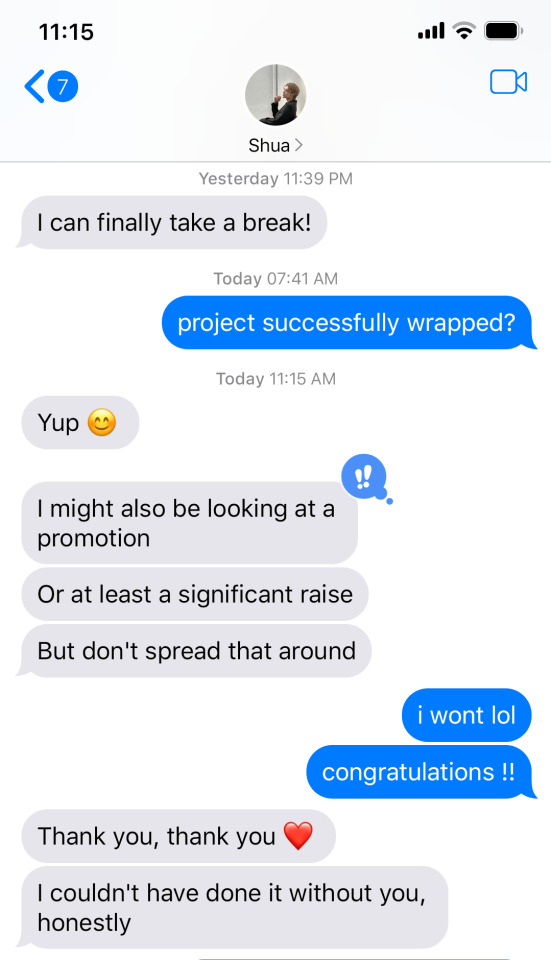#intrinsic motivation>>>>> extrinsic motivation
Explore tagged Tumblr posts
Text
✧ the cards are never in your favour ✧ (joshua x tarot! reader) part two
part : 1 I 2 I 3
(a/n : part two of my tarot! reader series. i was going kind of crazy of mingao's new ep and working on this distracted me a lot xd. to understand the worldbuilding, its better to read part one first. but no pressure!)
╰── ⋅ ⋅ ── ✩ ── ⋅ ⋅ ──╯╰── ⋅ ⋅ ── ✩ ── ⋅ ⋅ ──╯╰── ⋅ ⋅ ── ✩












╰── ⋅ ⋅ ── ✩ ── ⋅ ⋅ ──╯╰── ⋅ ⋅ ── ✩ ── ⋅ ⋅ ──╯╰── ⋅ ⋅ ── ✩
#only one last part to go!#whew#it ain't much but its honest work#also no one wants to know this but i really like when i work on something for myself#intrinsic motivation>>>>> extrinsic motivation#seventeen#svt#seventeen imagines#seventeen drabbles#seventeen fanfic#joshua#seventeen x oc#seventeen x reader#seventeen x you#seventeen x y/n#joshua hong#joshua x reader#joshua x you#joshua x y/n#writings of tie-dye
28 notes
·
View notes
Text
I’m assuming people know this but isagi’s “ego types” he’s ‘created’ are real theory
like how flow state is an actual thing, not just made up for blue lock
self-style ego vs world-style ego is literally just intrinsic vs extrinsic motivation

So world-type (aka isagi, hiori, reo etc) would be extrinsic motivation and self-type (aka shidou, bachira, nagi) would be intrinsic motivation
I hope this is taken further with in the manga and is actually discussed with all players, not just kept as theory in isagi’s head
#intrinsic vs extrinsic motivation theory is talked about a lot with sports so it doesn’t surprise me that kaneshiro would incorporate it#he’s just explaining it though isagi’s pov/wording#it’s 11pm and I have work at 7am tomorrow morning but I might read up on more when I get home after 4#bllk#blue lock#blue lock meta#meta#do I even tag this as meta cause I kinda just stated a fact
82 notes
·
View notes
Text
how to scientifically overcome executive dysfunction (Intrinsic Motivation + Self Determination Theory)
#motivation#study tips#study blog#studyblr#tiktok#executive dysfunction#self determination theory#intrinsic motivation#intrinsic vs extrinsic motivation
19 notes
·
View notes
Text
god psychology is so INTERESTING we are so back boys. Intrinsic vs extrinsic motivation is what we’re excited about today. Time for me to ramble about psychology!!
So intrinsic motivation is when you want to engage in an activity because you enjoy it and find it interesting. So something like playing video games, watching tv, drawing, writing etc. whatever it is you do just because you like doing it.
And extrinsic motivation is the things you do because you have to or feel you SHOULD. Whether there is a reward for doing the thing or pressure to do the thing, those are both extrinsic motivation. So if your parents want you to go to law school, or if you’ll get money if you go to work.
now the thing that’s fascinating is the RELATION between the two. Because in the simplest of terms, intrinsic motivation is seen as “better” than extrinsic motivation. And you’ve probably heard that before like oh you shouldn’t rely on other people to provide you happiness or whatever like it comes from within. Chances are you’ve thought “cool theory bro. Not as easy in practice though”. (And to be clear, it’s not. Desire for external validation is a whole other ball game)
Now the really interesting thing comes from the studies! They did this with a bunch of young kids and they gave them a bunch of random toys to play with. The toy they were testing was magic markers They essentially had three groups for the kids.
Kids who played with the markers of their own free will, just cause they liked them and didn’t get rewarded for it
Kids who played with the markers out of free will but then got an unexpected reward for it
And kids who were told they’d get a reward if they played with the markers
So they did all that then came back a few weeks later to test it again with the same group, but no rewards this time. And people who played with the markers of their own free will and got no reward played with the markers just as much as before (this is an example of intrinsic motivation)
BUT both the kids in group 2 and 3 played with the markers LESS when there wasn’t a reward. Like it makes sense for group 3 you take away the reward and you lose the motive. But group 2 originally had intrinsic motivation! But by providing that reward for something they did intrinsically they were less likely to do it in the future because they wouldn’t get a reward out of it.
Which to me is already super interesting but like when you apply it to real life it’s even more so!! Like let’s look at the job market with this in mind for a second. Let’s say you’re a teenager, who is financially supported by adults in your life. You don’t NEED money or a job. But you’ve got a really strong love of animals. So you go and volunteer at your local animal shelter. You do this because you love it, and are intrinsically motivated to do it. Let’s say you work there for a bit, and then you’re offered a job! You go yeah I like being here, I’ll take it! So now you’re getting paid to work at the animal shelter. Great, because you’re making money! You work there for a few months, but let’s say the shelter is losing money. They can’t pay people anymore, they have to work on a strictly volunteer basis. You don’t have that as a job anymore. The chances of you going back to volunteer are significantly lower than if you had never had a job at all. You’ve lost your external reward, and that took over your internal motivation.
It’s not that people don’t like things! It’s the power that reward has on you! People experience that intrinsic motivation ALL the time! But when you like or are good at something people try to make money off of it (understandable given the society we live in) but because of that you aren’t doing it for enjoyment anymore you’re doing it for money and you need money to live! So because we’ve created a society where money is so important and people are trying to capitalize off of their hobbies (again, understandable) people are actually way more likely to LOSE interest in those things because of it! It’s not that you’re just miserable and hate everything you used to love your motivation has just changed!!
Idk idk this isn’t very eloquent at all but I think looking at society like this and then the impact capitalism has on our well being and motivation because it essentially demands extrinsic motivation when we are objectively happier and more satisfied when we are intrinsically motivated is very very interesting
7 notes
·
View notes
Text
what if - hear me out! what if instead of working on my fic, i simply post the half-finished first chapter
#the untamed#mdzs#i think I'm onto something#fanfic#writeblr#and then everyone cheers me on and i get so much validation and praise that the unhealthy little sister of intrinsic motivation (extrinsic#motivation) kicks in and i write the rest of the fic and then i get even MORE praise and my mental health miraculously heals and my grades#pick up and i finish my thesis with full points and gets published in some amazing paper and i get a well paid and fun job and my cat turns#immortal.#fool proof
6 notes
·
View notes
Text
It feels like reading is a bit... higher-stakes than it used to be?
You have to read because all the articles say it's good for your mental health, your empathy, and your attention span. You have to read to keep up with what people are talking about, otherwise you'll be left out of the conversation (but you shouldn't just jump on any viral bestseller bandwagon). You have to read because a friend (or just some person online) recommended this book really enthusiastically, and you don't want to ignore them, do you? You have to read (preferably indie) to support authors, publishers, booksellers, and libraries. You have to read (specific authors/books/subgenres) to prioritise marginalised groups and decentre privileged ones. You have to read because suddenly you can't keep up with all the bookstagram/booktok/Goodreads people who get through 100+ books a year. You have to read to get through your TBR, because you must get through your TBR. You have to read because everyone should read these classics at least once in their life. And of course, you have to read so you can still say you read.
I'm not saying these are necessarily bad goals (some of them are very good and important). And I hope I don't come off as sounding like a whiny privileged person having a tantrum at being asked to think about things other than themselves. But having all these things in the back of my mind generates pressure and makes reading feel more like a demand than a fun activity.
#stuff in my life#huh. maybe it's to do with extrinsic vs intrinsic motivation etc#anyway i did not realise how much this sounds like the speech from barbie until i typed it out
10 notes
·
View notes
Text
I agree that the motive to work hard for your partner(s) shouldn't be out of fear of losing them, and I don't want to conflate OP's rejection of the former in this post with complacency - this vulnerability and trust is the *basis* of love - but an effort to do more for your partner(s) for mutual sake is important to me. I don't think challenging oneself to do more is necessarily some kind of sisyphian display.
I also don't think conditional love is always bad - in fact, I think healthy conditions are what we might call 'boundaries'.
OP is likely rejecting the task of showing love moreso if taken up out of fear, as well as rejecting unreasonably conditional love, but I do think there is a preferable middle ground to both frantically conditional love and totally unconditional love. I think love *itself* is rest, vulnerability, and trust, but to love and be loved is more than that.
having to come to terms with the fact that love is not an everlasting performance in which you attempt to retain the attention of your significant other but rather a release of control and putting faith into them and trusting them to choose to stay with you no matter what you have to offer
#i dont usually make posts#but the assertion that love is unconditional feels a bit scary to me#though intrinsic motivation definitely is more important in this kind of love than extrinsic
227K notes
·
View notes
Text
How Internal and External Rewards Shape Our Behavior

View On WordPress
#balance#extrinsic motivation#goals#intrinsic motivation#motivation#personal journey#rewards#success
1 note
·
View note
Text
Uzbekistan: Motivazione ed efficacia didattica nella psicologia pedagogica"
Abstract. Questo articolo studia la motivazione interna ed esterna degli studenti nel processo educativo, il loro atteggiamento verso le loro attività educative e il loro impatto sui loro risultati. Evidenzia inoltre l’impatto delle moderne tecnologie educative sulla motivazione e il ruolo degli insegnanti in questo processo. Introduzione Innanzitutto, è opportuno comprendere il concetto di…
#AK Markova#Alessandria today#Bruner theory#classroom motivation#cognitive motivation#digital education tools#education in the 21st century#educational psychology#educational success#effective learning processes#extrinsic motivation#Google News#internal drive#intrinsic motivation#italianewsmedia.com#Lava#learning environment#learning outcomes#lifelong learning#Maslow theory#motivation and behavior#motivation and cognition#motivation in learning#motivation in youth#motivational psychology#motivational techniques#negative motivation#pedagogical strategies#Pier Carlo#positive learning
0 notes
Text
Success is not an antidote for not liking yourself, and it's not a valid replacement for self-worth.
External validation is not a substitute for internal validation.
0 notes
Text
Master Your Motivation: A Practical Guide
Have you ever been frozen? Not literally, though that would not be good either. But in your tasks for the day? Like open your emails to see (205) in your Inbox. Or have a to-do list a mile long? Me too, I researched motivation and discovered we all have it! Bonus: we can also change which type of motivation we harnes for our daily use, and here is how.
We’ve all been there: staring & keeping that mile-long to-do list, often feeling utterly uninspired. Motivation, that elusive force that propels us forward, can feel like a fickle friend. But what if you understood the different types of motivation and how to harness them? What if you learned to categorize your tasks and strategically apply practical solutions? Let’s dive in. The Motivation…

View On WordPress
#achievement#affiliation#belief#buildmomentum#dailyhabits#extrinsic#intrinsic#motivation#perfectionist#power#progressoverperfections#sayYes#to-do
0 notes
Text
The Secret Sauce of Motivation
Motivation is a funny thing. Some athletes seem to have an endless supply of it, showing up early, staying late, and grinding even when no one’s watching. Others? Well, let’s just say if motivation were a gas tank, they’re perpetually running on E. As coaches, we talk about motivation all the time—how to build it, maintain it, and, in some cases, resuscitate it like a defibrillator at a CPR…
#Athlete Development#coaching strategies#coaching tips#intrinsic vs extrinsic#mental performance#Motivation#Sports Psychology#Youth Sports
0 notes
Text
Motivation is an intrinsic thing - How do you find yours
Motivation is often described as the spark that drives action. Whether it’s achieving a goal, starting a new project, or simply getting through a challenging day, motivation plays a key role in how we navigate our lives. But unlike external rewards or encouragement, true motivation is intrinsic—it comes from within. It’s a deeply personal force tied to our values, interests, and purpose. So how…

View On WordPress
#Building self-driven habits#Discovering your motivation source#Finding your inner motivation#How to stay self-motivated#Intrinsic motivation tips#Intrinsic vs. extrinsic motivation#Steps to find your personal motivation#Strategies to ignite self-motivation#The power of intrinsic motivation#Unlocking personal motivation
0 notes
Video
youtube
The Power of Intrinsic Motivation | Unlocking the Drive Within
0 notes
Text

1 note
·
View note
Text
for me, consulting writing advice is always more confusing than not. like when you tell me to start my literary essay with "an attention-grabbing first sentence" i'm like, i've literally been told my whole life that every thought i have about literature is boring to most people. my own attention is already siezed; as for "grabbing" other people's, you can't ask me how i expect to do that.
#i literally AM a good essay writer though#i just struggle so much with interpreting vague advice#and i know that stuff is usually written for people who do NOT normally write long literary analyses for fun#but the thing is. even if i'm generally confident in my literary interpretation and explication skills#it's still always a Task to start an essay#especially one i have extrinsic rather than intrinsic motivation to write#ie i am writing this essay bc i am supposed to. but when i write pages upon pages in my notebooks about how much i loved cymbeline#that was bc i honest-to-god wanted to#and i still enjoy the task when it is a direction given to me don't get me wrong#it's just Hard to Start#thats ok#for all my experience and recognition ive gotten for it over the years. i really do think reading and writing are hard skills#they're intellectual exercises for everyone#just bc i do it regularly doesnt mean im always just sharp and it comes easily to me#i eat every day. but if i stopped i would get sick and die#feeding your head is the same way. you have to satisfy that hunger for knowledge#you always have to revitalize your intellect#tales from diana#god im pretentious#you know what. im allowed to be a little self-confident in one of the few things i know im better at than the average person#i really dont think i do many things that many ppl arent capable of#but it's still an effort for me as it is an effort for everyone
1 note
·
View note